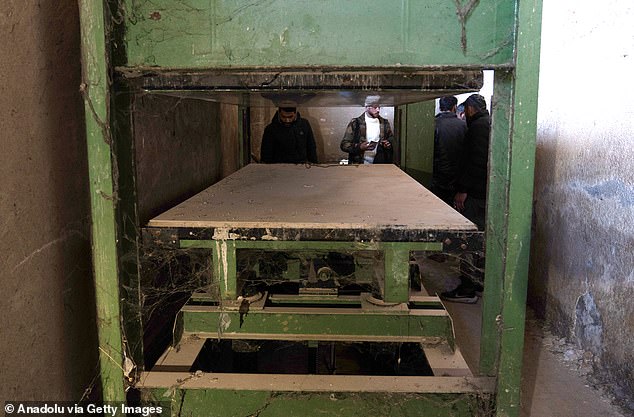A former inmate in one of Syrian dictator Bashar al-Assad’s prisons has revealed how he saw a boy crying for his mother while his torturers sexually abused him.
René, one of six million Syrians who fled the country after the brutal 2012 civil war, was jailed for being gay and for attending a pro-democracy protest organized by Assad’s secret police.
He said that while in prison, he saw a boy no older than 16 being raped by Assad’s guards.
René told the BBC: ‘There was a boy. I was 15 or 16 years old. They were raping him and he called his mother. He would say, ‘Mom… my mother… mom.’
René himself was also raped by three guards who laughed when he begged for mercy.
‘No one listened to me. “I was alone,” he recalled in 2012.
He said the same guard abused him every six months.
The former prisoner said memories of his time in the horrific prison system came back to him as he saw the swath of prisoners leaving Damascus after Assad’s fall.
An aerial view of the Sednaya military prison after armed groups opposing the Syrian regime of Bashar al-Assad took control in Damascus.

A view of the corpses, which were tortured to death, at Al-Mujtahid Hospital as teams carry out an investigation in secret compartments of the Sednaya prison after the fall of the Assad regime in Damascus, Syria, on 10 December 2024.
‘Now I’m not in prison, I’m here. But I saw myself in the photographs and in the images of the people in Syria. I was very happy for them, but I saw myself there,’ he said.
‘I saw the old version of me there. I saw when they raped me and when they tortured me. I saw everything in flashback.’
Since Assad’s fall, the conditions of the prisons he ran have been revealed in detail for the first time.
The infamous Sednaya prison near Damascus, nicknamed the “human slaughterhouse”, was the epicenter of this systematic terror in which large numbers of detainees were subjected to all kinds of inhuman treatment and executed.
Rebel fighters were imprisoned along with intellectuals, activists, and ordinary civilians; All were subjected to atrocious treatment, in many cases over several decades.
The Syrian Network for Human Rights says that since the start of the Syrian revolution in March 2011, more than 157,000 people remain arrested or have been forcibly disappeared, including 5,274 children and 10,221 women.
More than 15,000 people are said to have died under torture during that time.
The network also documented 72 different regime torture methods that included electrocuting genitals or hanging weights from them; burning with oil, metal rods, gunpowder or flammable pesticides; crushing heads between a wall and a prison cell door and inserting metal needles or pins into bodies.

A view of the corpses, which were tortured to death, at Al-Mujtahid Hospital as teams carry out an investigation in secret compartments of the Sednaya prison after the fall of the Assad regime in Damascus, Syria, on 10 December 2024.

A view of corpses that were tortured to death at Harasta Military Hospital as teams conduct an investigation in secret compartments of Sednaya Prison.

It is believed that this “iron press” was used to crush, torture and execute prisoners.
For most detainees, the horror began immediately after arrest, often with savage beatings on the way to detention centers.
The prisoners endured brutal ‘welcome parties’, where they were flogged with hoses, silicone bars and wooden sticks.
Survivors have described being suspended by their wrists for hours, suffering electric shocks and being burned with cigarettes, in horrific accounts provided to the New York Times and Amnesty International.
Once trapped behind bars, prisoners quickly became familiar with all sorts of novel torture methods, some so notorious that they received obscure nicknames.
In one such grotesque device, nicknamed the “flying carpet,” prisoners were chained to a board attached to a flexible board divided in half by metal chain hinges.
The guards would then lift the bottom half of the board and bend the prisoner’s legs towards them, slowly and excruciatingly crushing them into horrible positions.
Another such torture tactic was called ‘dulab’, in which victims’ bodies were contorted into rubber tires, with their heads pressed against their knees, before being rolled and beaten mercilessly.
It is said that many guards delighted in inflicting such cruelty.
Inmates often had to perform macabre and degrading performances, forced to imitate animals (dogs, donkeys and cats) and beaten for any misstep.


